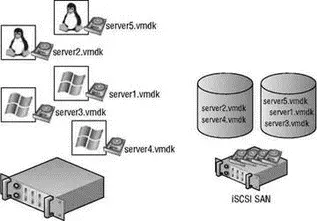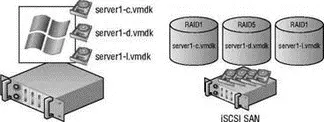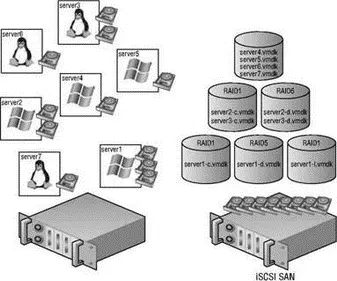Chris McCain - Mastering VMware® Infrastructure3
Здесь есть возможность читать онлайн «Chris McCain - Mastering VMware® Infrastructure3» — ознакомительный отрывок электронной книги совершенно бесплатно, а после прочтения отрывка купить полную версию. В некоторых случаях можно слушать аудио, скачать через торрент в формате fb2 и присутствует краткое содержание. Город: Indianapolis, Год выпуска: 2008, ISBN: 2008, Издательство: WILEY Wiley Publishing, Inc., Жанр: Программы, ОС и Сети, на английском языке. Описание произведения, (предисловие) а так же отзывы посетителей доступны на портале библиотеки ЛибКат.
- Название:Mastering VMware® Infrastructure3
- Автор:
- Издательство:WILEY Wiley Publishing, Inc.
- Жанр:
- Год:2008
- Город:Indianapolis
- ISBN:978-0-470-18313-7
- Рейтинг книги:5 / 5. Голосов: 1
-
Избранное:Добавить в избранное
- Отзывы:
-
Ваша оценка:
- 100
- 1
- 2
- 3
- 4
- 5
Mastering VMware® Infrastructure3: краткое содержание, описание и аннотация
Предлагаем к чтению аннотацию, описание, краткое содержание или предисловие (зависит от того, что написал сам автор книги «Mastering VMware® Infrastructure3»). Если вы не нашли необходимую информацию о книге — напишите в комментариях, мы постараемся отыскать её.
Mastering VMware® Infrastructure3 — читать онлайн ознакомительный отрывок
Ниже представлен текст книги, разбитый по страницам. Система сохранения места последней прочитанной страницы, позволяет с удобством читать онлайн бесплатно книгу «Mastering VMware® Infrastructure3», без необходимости каждый раз заново искать на чём Вы остановились. Поставьте закладку, и сможете в любой момент перейти на страницу, на которой закончили чтение.
Интервал:
Закладка:
RAID 1+0/RAID 0+1 For a more advanced disk array configuration, a RAID 1+0 or RAID 0+1 might be used. These structures combine the use of RAID 0 and RAID 1 technologies. RAID 1+0 involves mirroring a stripe, while RAID 0+1 involves striping several mirrors.
One of the most common challenges facing VI3 administrators is the process of sizing LUNs. Administrators can quite easily determine the RAID levels of a LUN (as explained in the preceding paragraphs), but sizing the LUN is an entirely different challenge. To determine the size of a LUN, administrators must have a game plan for testing virtual machine performance or have a solid understanding of the functions of the virtual machine(s) to be located on a LUN.
There is no definitive answer to this question, simply because administrators can choose to build virtual machines with virtual hard drives of varying sizes. There is, however, a generic but effective way of determining size requirements for a virtual machine. For each virtual machine, there is a set of associated files that have a direct influence on storage requirements, including the virtual machine hard disk, the suspended state, and the virtual machine swap file. Use the following formula to calculate the storage requirements for a virtual machine:
+ + = minimum storage requirement for a virtual machine
For example, if a virtual machine consisted of a 25GB Virtual Machine Disk Format (VMDK) file, a memory limit of 4GB, and a memory reservation of 2GB, the minimum storage requirement could be calculated as follows:
25GB (virtual machine) +25GB (suspended state) +2GB (limit - reservation) = 52GB
In this case, a 55GB LUN would suffice for the virtual machine. However, keep in mind that if you decide to increase the RAM limit to 8GB or to reduce the RAM reservation to 0, you will then be jeopardizing the accuracy of the minimum storage requirement calculation.
Storage space for snapshots should also be considered, even if only for the temporary duration of the snapshot process (see Chapter 6). Luckily for SAN and VI3 administrators, the placement of a virtual machine's files is not a permanent decision. Moving a virtual machine to different storage locations is a simple but offline process.
When it comes to LUN design and management, VMware defines two common philosophies:
♦ The adaptive scheme
♦ The predictive scheme
Each scheme offers its own set of advantages and disadvantages to VI3 administrators. Undoubtedly, you will find that neither option is the appropriate solution in every situation. It is safe to say that most administrators will find themselves incorporating a blend of both philosophies as a means of compromise and earning the best of both worlds.
Adaptive Scheme
We'll start by introducing the adaptive scheme because of its simplicity. The adaptive scheme involves creating a small number of larger LUNs for the storage of virtual machines. The adaptive scheme results in fewer requirements on the part of the SAN administrator, less effort when performing LUN masking, fewer datastores to manage, and better opportunities for virtual disk resizing.
The downside to the adaptive scheme is the increased contention for LUN access across all of the virtual machines in the datastore. For example, if a 500GB LUN holds the virtual machine disk files for 10 virtual machines, then there will be contention among all of the virtual machines for access to the LUN. This might not be an issue, as the virtual machines' disk files residing on the LUN may be for virtual machines that are not disk intensive — that is, they do not rely heavily on hard disk input/output (I/O). For the adaptive scheme to be a plausible and manageable solution, VI3 administrators must be proactive in monitoring the virtual machines stored together on a LUN. When the performance of the virtual machines begins to reach unacceptable levels, administrators must look to creating more LUNs to be made available for new or existing virtual machines. Figure 4.7 shows an implementation of the adaptive scheme for storing virtual machines.
Predictive Scheme
The predictive scheme overcomes the limitations of the adaptive scheme but introduces administrative challenges of its own. The predictive involves the additional administrative effort of customizing LUNs to be specific for individual virtual machines. Take the following example: When administrators deploy a new server to play host to a database application, it is a common practice to enhance database performance by implementing multiple disks with characteristics specific to the data stored on the disk. On a database server, this often means a RAID 1 (mirror) volume for the operating system, a RAID 5 volume for the database files, and another RAID 1 volume for the database logs. Using the predictive scheme to architect a LUN solution for this database server would result in three SAN LUNs built on RAID arrays as needed by the database server. The sizes of the LUNs would depend on the estimated sizes of the operating system, database, and log files. Figure 4.8 shows this type of predictive approach to LUN design. Table 4.2 outlines all of the pros and cons for each of the LUN design strategies.

Figure 4.7The adaptive scheme involves creating a small number of LUNs that are larger in size and play host to virtual machine disk files for multiple virtual machines.

Figure 4.8The predictive scheme, though administratively more involved, offers better performance measures for critical virtual machines.
Table 4.2: Adaptive and Predictive Scheme Comparisons
| Type of Scheme | Pros | Cons |
|---|---|---|
| Adaptive | Less need for SAN administrator Easy resizing of virtual disks Easy snapshot management Less volume management | Possible undersizing of LUN, resulting in greater administrative effort to create new LUNs Possible oversizing of LUN, resulting in wasted storage space |
| Predictive | Less contention on each VMFS More flexible share allocation and management Less wasted space on SAN storage RAID specificity for VMs Greater multipathing capability Support for Microsoft clusters Greater backup policy flexibility | Greater administrative overhead for LUN masking Greater administrative effort involved in VMotion, DRS, and HA planning |
As we noted earlier in this section, the most appropriate solution will most likely involve a combination of the two design schemes. You may find a handful of virtual machines where performance is unaffected by storing all the virtual machine disk files on the same LUN, and at the same time you will find those virtual machines that require a strict nonsharing approach for the virtual machine disk files. But in between the two extremes, you will find the virtual machines that require specific RAID characteristics but, at the same time, can share LUN access with multiple virtual machines. Figure 4.9 shows a LUN design strategy that incorporates both the adaptive and predictive schemes as well as a hybrid approach.

Figure 4.9Neither the adaptive nor the predictive scheme will be the most appropriate solution in all cases, which means most environments will be built on a hybrid solution that involves both philosophies.
Читать дальшеИнтервал:
Закладка:
Похожие книги на «Mastering VMware® Infrastructure3»
Представляем Вашему вниманию похожие книги на «Mastering VMware® Infrastructure3» списком для выбора. Мы отобрали схожую по названию и смыслу литературу в надежде предоставить читателям больше вариантов отыскать новые, интересные, ещё непрочитанные произведения.
Обсуждение, отзывы о книге «Mastering VMware® Infrastructure3» и просто собственные мнения читателей. Оставьте ваши комментарии, напишите, что Вы думаете о произведении, его смысле или главных героях. Укажите что конкретно понравилось, а что нет, и почему Вы так считаете.












